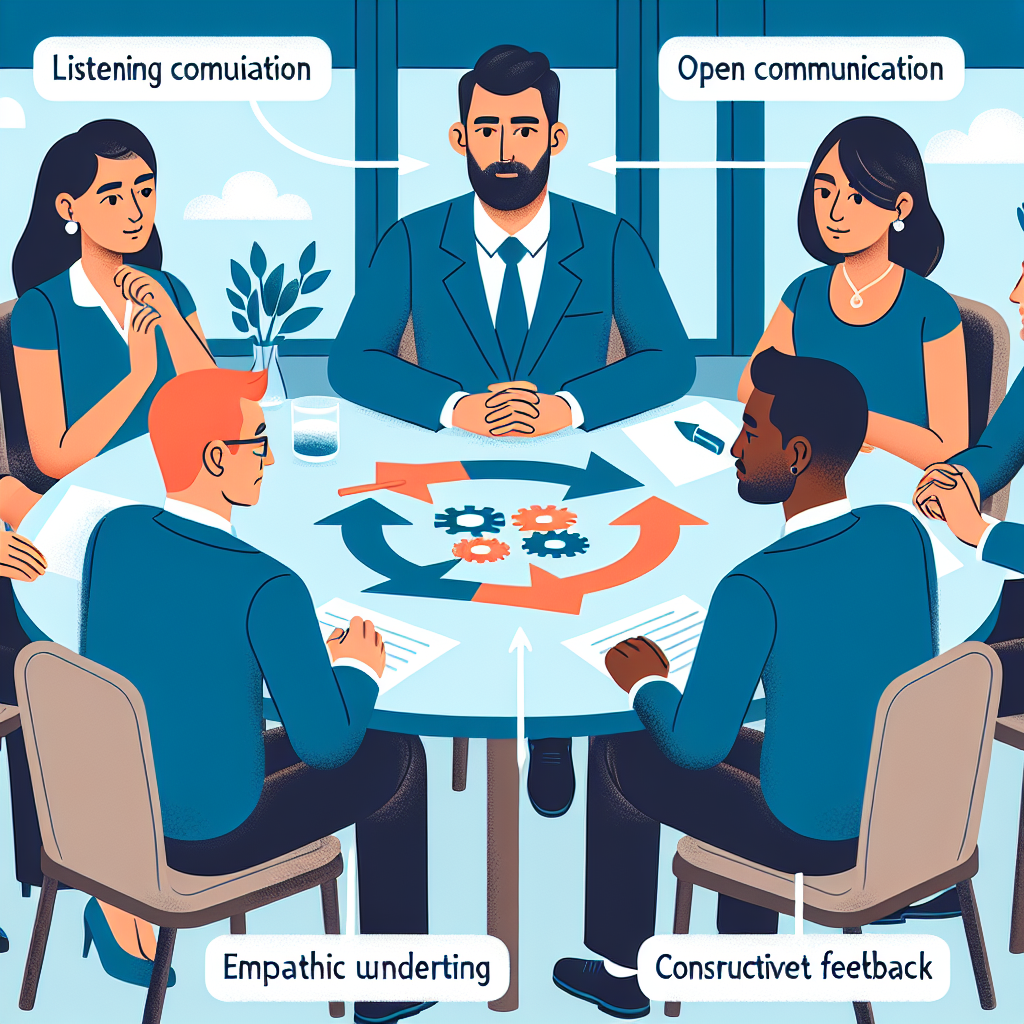
Understanding the Root Causes of Conflict in the Workplace
Conflict is an inevitable part of any workplace. With different personalities, opinions, and goals, it is only natural that conflicts will arise. However, if not handled properly, these conflicts can have a negative impact on the overall productivity and morale of the workplace. That is why it is crucial for employees and employers alike to understand the root causes of conflict in the workplace and learn effective ways to resolve them.
One of the main reasons for conflicts in the workplace is communication breakdown. In a fast-paced work environment, miscommunication can easily occur, leading to misunderstandings and conflicts. This can happen between colleagues, between employees and managers, or even between different departments. When communication is not clear and effective, it can create a ripple effect, causing tension and conflicts to arise.
Another common cause of conflict in the workplace is differences in personalities and work styles. Each individual has their own unique way of working and dealing with situations. When these differences clash, it can lead to conflicts. For example, an employee who prefers to work independently may have conflicts with a colleague who prefers to work in a team. These differences can also be seen in communication styles, decision-making processes, and problem-solving approaches.
Moreover, conflicts can also arise due to differences in values and beliefs. In a diverse workplace, employees may come from different backgrounds and have different cultural or religious beliefs. When these beliefs clash, it can lead to misunderstandings and conflicts. For instance, an employee who values punctuality may have conflicts with a colleague who has a more relaxed attitude towards time management.
Another factor that can contribute to conflicts in the workplace is competition. In a competitive work environment, employees may feel the need to outperform their colleagues to get recognition or promotions. This can create a sense of rivalry and lead to conflicts. Additionally, when there is a lack of clear goals and expectations, employees may compete for resources or recognition, causing conflicts to arise.
Furthermore, conflicts can also be a result of poor leadership and management. When managers fail to address conflicts or favor certain employees, it can create a toxic work environment. This can lead to resentment and conflicts among employees. Additionally, when managers do not communicate effectively or make decisions without considering the opinions of their team, it can also lead to conflicts.
Understanding the root causes of conflicts in the workplace is the first step towards effective conflict resolution. By identifying the underlying issues, employees and employers can work towards finding a solution that benefits everyone. This can be achieved through open and honest communication, where each party can express their concerns and perspectives.
Moreover, promoting a culture of respect and understanding can also help prevent conflicts in the workplace. When employees are encouraged to embrace diversity and differences, it can create a more harmonious work environment. This can be achieved through team-building activities, diversity training, and promoting a culture of open-mindedness.
In conclusion, conflicts in the workplace are inevitable, but they can be managed and resolved effectively. By understanding the root causes of conflicts, employees and employers can work towards creating a more positive and productive work environment. Effective communication, promoting a culture of respect, and addressing conflicts promptly and fairly are key to resolving conflicts in the workplace. By implementing these strategies, conflicts can be turned into opportunities for growth and improvement, leading to a more cohesive and successful workplace.
Effective Communication Strategies for Resolving Conflict
Conflict is an inevitable part of any workplace. With different personalities, opinions, and work styles, it’s only natural that conflicts will arise. However, how these conflicts are handled can make all the difference in maintaining a positive and productive work environment. Effective communication is key to resolving conflicts in the workplace, and in this article, we will explore some strategies for achieving successful conflict resolution.
The first step in resolving conflicts is to acknowledge that they exist. Many people tend to avoid conflicts, hoping they will go away on their own. However, this approach often leads to the conflict escalating and becoming more difficult to resolve. It’s important to address conflicts as soon as they arise, before they have a chance to fester and cause more damage.
One of the most important communication strategies for resolving conflicts is active listening. This means truly listening to the other person’s perspective without interrupting or judging. It’s important to give the other person the opportunity to express their thoughts and feelings without feeling attacked. Active listening also involves asking clarifying questions and summarizing what the other person has said to ensure understanding.
Another effective communication strategy is to use ”I” statements instead of ”you” statements. ”You” statements can come across as accusatory and can escalate the conflict. On the other hand, ”I” statements focus on your own feelings and perspective, which can help the other person understand your point of view without feeling attacked. For example, instead of saying ”You never listen to my ideas,” try saying ”I feel like my ideas are not being heard.” This approach can help to de-escalate the conflict and promote open communication.
It’s also important to remain calm and respectful during conflicts. It’s natural to feel angry or frustrated during a conflict, but it’s important to keep emotions in check and avoid personal attacks. Instead, focus on the issue at hand and try to find a solution together. Taking a break if emotions are running high can also be helpful in diffusing the situation.
Another effective communication strategy is to use ”I” language instead of ”we” language. ”We” language can create a sense of blame and can make the other person defensive. Using ”I” language, such as ”I feel like we are not on the same page,” can help to avoid placing blame and promote a collaborative approach to finding a solution.
It’s also important to be open to compromise and finding a win-win solution. In conflicts, it’s easy to get caught up in wanting to be right and having the other person concede. However, this approach rarely leads to a satisfactory resolution. Instead, try to find a solution that meets the needs of both parties. This can involve brainstorming together and being open to different perspectives.
Lastly, it’s important to follow up after a conflict has been resolved. This can involve checking in with the other person to ensure that the solution is working and addressing any lingering issues. It’s also important to reflect on the conflict and identify any patterns or triggers that may have led to it. This can help to prevent similar conflicts from arising in the future.
In conclusion, effective communication is crucial for resolving conflicts in the workplace. By actively listening, using ”I” statements, remaining calm and respectful, using ”I” language, being open to compromise, and following up, conflicts can be resolved in a positive and productive manner. Remember, conflicts are a natural part of any workplace, but how they are handled can make all the difference in maintaining a healthy and harmonious work environment.
The Importance of Active Listening in Conflict Resolution
Conflict is an inevitable part of any workplace. With different personalities, opinions, and work styles, it’s only natural that conflicts will arise. However, how these conflicts are handled can make all the difference in maintaining a positive and productive work environment. One of the key secrets to effective conflict resolution in the workplace is active listening.
Active listening is a communication technique that involves fully concentrating on what the other person is saying, understanding their perspective, and responding appropriately. It goes beyond just hearing the words being said, but also understanding the underlying emotions and motivations behind them. In the context of conflict resolution, active listening is crucial in understanding the root cause of the conflict and finding a mutually beneficial solution.
The first step in active listening is to give the other person your undivided attention. This means putting away any distractions, such as phones or laptops, and making eye contact. By doing so, you are showing the other person that you value what they have to say and are fully present in the conversation.
Next, it’s important to listen without judgment. Often, in conflicts, we tend to jump to conclusions or make assumptions about the other person’s intentions. This can hinder effective communication and escalate the conflict further. Instead, try to listen with an open mind and without any preconceived notions. This will allow you to truly understand the other person’s perspective and find common ground.
As you listen, it’s essential to also pay attention to non-verbal cues. These can include body language, tone of voice, and facial expressions. Sometimes, what is not being said can be just as important as what is being said. For example, if someone is speaking in a calm tone but their body language is tense, it could indicate that they are feeling agitated or defensive. By picking up on these cues, you can adjust your approach and respond accordingly.
Another crucial aspect of active listening is asking clarifying questions. This not only shows that you are actively engaged in the conversation, but it also helps to ensure that you have a clear understanding of the other person’s perspective. Clarifying questions can also help to uncover any underlying issues that may be contributing to the conflict.
It’s also important to practice reflective listening. This involves paraphrasing what the other person has said to ensure that you have understood them correctly. It also allows the other person to clarify any misunderstandings and feel heard and validated. For example, you could say, ”What I’m hearing is that you feel frustrated because you feel like your ideas are not being taken into consideration. Is that correct?” This shows that you are actively listening and trying to understand their perspective.
In addition to these techniques, it’s also crucial to remain calm and composed during the conversation. Conflicts can often become heated and emotional, but it’s important to stay level-headed and avoid getting defensive. This will allow you to respond rationally and find a solution rather than escalating the conflict further.
Active listening is not only beneficial in resolving conflicts, but it also helps to build stronger relationships in the workplace. When employees feel heard and understood, it can improve trust and communication within the team. It also creates a more positive and collaborative work environment.
In conclusion, active listening is a crucial skill in effective conflict resolution in the workplace. By giving your undivided attention, listening without judgment, paying attention to non-verbal cues, asking clarifying questions, and practicing reflective listening, you can better understand the other person’s perspective and find a mutually beneficial solution. It takes practice and patience, but the results are worth it in creating a harmonious and productive workplace.
Utilizing Mediation and Negotiation Techniques for Successful Resolution
Conflict is an inevitable part of any workplace. With different personalities, opinions, and goals, it is bound to happen. However, how we handle these conflicts can make all the difference in maintaining a positive and productive work environment. In this article, we will explore the secrets to effective conflict resolution in the workplace, specifically through the use of mediation and negotiation techniques.
Mediation is a process where a neutral third party helps facilitate a conversation between two conflicting parties. It allows for open communication and understanding between the parties involved. The mediator’s role is not to make decisions or take sides but to guide the conversation towards a mutually beneficial resolution.
One of the key secrets to effective conflict resolution through mediation is active listening. This means truly hearing and understanding the other person’s perspective without judgment or interruption. It is essential to listen not just to the words being said but also to the underlying emotions and needs. By actively listening, the mediator can help the parties find common ground and work towards a resolution that meets everyone’s needs.
Another important aspect of mediation is creating a safe and respectful environment for the parties to express themselves. This means setting ground rules for the conversation, such as no interrupting or name-calling. It also means acknowledging and validating each person’s feelings and perspectives. When people feel heard and respected, they are more likely to be open to finding a resolution.
In addition to mediation, negotiation techniques can also be useful in resolving conflicts in the workplace. Negotiation is a process where both parties come together to find a mutually acceptable solution. Unlike mediation, negotiation involves both parties actively participating in the decision-making process.
One of the secrets to successful negotiation is understanding the other party’s interests and needs. Often, conflicts arise because each party is focused on their own position rather than understanding the other’s perspective. By asking open-ended questions and actively listening, negotiators can uncover the underlying interests and needs of the other party. This allows for a more collaborative and creative approach to finding a resolution.
Another important aspect of negotiation is being able to separate the people from the problem. In a workplace setting, conflicts can become personal, and emotions can run high. It is crucial to focus on the issue at hand and not let personal feelings or biases cloud the negotiation process. By separating the people from the problem, negotiators can maintain a professional and productive conversation.
Effective communication is also key in successful negotiation. This means being clear and concise in expressing one’s needs and interests. It also means being an active listener and asking clarifying questions. Miscommunication can often lead to misunderstandings and further conflicts, so it is essential to communicate effectively during the negotiation process.
Lastly, it is crucial to have a win-win mindset when approaching conflict resolution through negotiation. This means looking for solutions that benefit both parties rather than just one. It also means being open to compromise and finding a middle ground. When both parties feel like they have gained something from the resolution, it is more likely to be sustainable in the long run.
In conclusion, conflicts in the workplace are inevitable, but they do not have to be detrimental. By utilizing mediation and negotiation techniques, conflicts can be resolved effectively, leading to a more positive and productive work environment. The key secrets to successful conflict resolution through these methods include active listening, creating a safe and respectful environment, understanding the other party’s interests, separating the people from the problem, effective communication, and having a win-win mindset. By implementing these strategies, conflicts can be turned into opportunities for growth and collaboration in the workplace.
Implementing Conflict Resolution Policies and Procedures in the Workplace
Conflict is an inevitable part of any workplace. With different personalities, opinions, and work styles, it’s only natural that conflicts will arise. However, if left unresolved, these conflicts can have a negative impact on the overall productivity and morale of the workplace. That’s why it’s crucial for organizations to have effective conflict resolution policies and procedures in place.
So, what are the secrets to implementing these policies and procedures successfully? Let’s take a closer look.
First and foremost, it’s essential to have a clear and well-defined conflict resolution policy in place. This policy should outline the steps that employees should take when conflicts arise, as well as the roles and responsibilities of managers and HR in resolving conflicts. It should also clearly state the consequences of not following the policy, such as disciplinary action.
Having a well-defined policy not only sets expectations for employees but also ensures consistency in how conflicts are handled. This can help prevent any bias or favoritism in the resolution process.
Another crucial aspect of effective conflict resolution is communication. Open and honest communication is key to resolving conflicts in the workplace. Employees should feel comfortable expressing their concerns and grievances without fear of retaliation. This can be achieved by fostering a culture of open communication and actively listening to employees’ concerns.
Managers and HR should also be trained in effective communication and conflict resolution techniques. This includes active listening, empathy, and the ability to remain calm and neutral in tense situations. These skills are essential in facilitating productive discussions and finding mutually beneficial solutions.
In addition to having a clear policy and effective communication, it’s also crucial to have a structured conflict resolution process. This process should include steps such as identifying the issue, gathering information, and involving all parties in finding a resolution. It’s also essential to have a designated mediator or facilitator who can guide the process and ensure that all parties are heard and respected.
It’s also important to note that conflicts should be addressed promptly. Ignoring or delaying conflict resolution can lead to the situation escalating and becoming more challenging to resolve. It’s best to address conflicts as soon as they arise, before they have a chance to impact the workplace negatively.
In some cases, conflicts may require a more formal approach, such as involving a third-party mediator or seeking outside help. In these situations, it’s crucial to have a clear escalation process in place. This process should outline the steps to be taken when conflicts cannot be resolved internally and who to involve in the resolution process.
Lastly, it’s essential to regularly review and update conflict resolution policies and procedures. As the workplace and its dynamics evolve, so should the conflict resolution process. Regularly seeking feedback from employees and evaluating the effectiveness of the policies and procedures can help identify any areas that need improvement.
In conclusion, implementing effective conflict resolution policies and procedures in the workplace requires a combination of clear policies, open communication, structured processes, and continuous evaluation. By following these secrets, organizations can create a positive and productive work environment where conflicts are resolved efficiently and amicably. Remember, conflicts are inevitable, but how we handle them can make all the difference.
Vi har mång spännande event inom Entreprenörskap, Investering och Personlig Utveckling. Du kan se alla här:
www.swedishwealthinstitute.se/event



